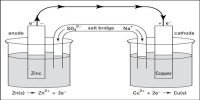Consider the zinc-copper cell, how can the emf of such a cell be calculated from the standard potentials, rather than by experiment? The two half-reactions are
Cu2+ (aq) + 2e– → Cu (s) and Zn (s) → Zn2+ (aq) + 2e–
The copper half-reaction is a reduction. Look up for ECu, the standard reduction potential for the following half-reaction.
Cu2+ (aq) + 2e– → Cu (s)
We find that ECu = + 0.34V.
The zinc half-reaction is an oxidation. Please note that tables usually list reduction potentials.
If EZn is the reduction potential of zinc, then EZn = – 0.76V as per the values found in the table above. Similarly, (- EZn) is the oxidation potential of zinc. Therefore, (- EZn). +0.76 V for the following half-reaction:
Zn (s) → Zn2+ (aq) + 2e–
The cell emf is the sum of the reduction potential for the copper half-cell and the oxidation potential for the zinc half-cell.
We can say that Ecell = ECu + (- EZn),
which is equal to Ecell = ECu – EZn
Therefore, Ecell = 0.34 + 0.76 = 1.1 V













